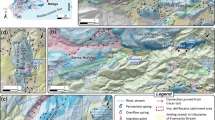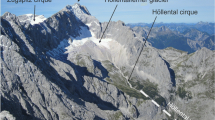Abstract
To investigate the hydrogeological characteristics of the karst trough zone in China, two groundwater systems (Yuquandong [YQD] and Migongquan [MGQ]) in Sixi Valley, western Hubei, were discussed. Seven groups of tracer experiments were conducted, with consideration of regional topography, geology and hydrogeology. By means of high-resolution continuous monitors, tracer breakthrough curves (BTC) of two systems were obtained and it was found that karst conduits of YQD system were more developed. From their hydrological and hydrochemical performance, two different systems were verified with relatively independent flow paths. Additionally, boundaries of the two systems were confirmed, sub-regions of recharge were delineated, and five conceptual models of groundwater recharge were determined, which are typical of the karst trough zone of China.







Similar content being viewed by others
References
Angelini P (1997) Correlation and spectral analysis of two hydrogeological systems in central Italy. Hydrol Sci J 42(3):425–438
Barberá JA, Mudarra M, Andreo B, De la Torre B (2018) Regional-scale analysis of karst underground flow deduced from tracing experiments: examples from carbonate aquifers in Malaga province, southern Spain. Hydrogeol J 26:23–40
Benischke R, Goldscheider N, Smart C (2007) Tracer techniques. In: Goldscheider N, Drew D (eds) Methods in karst hydrogeology. Taylor and Francis, London, pp 147–170
Birk S, Geyer T, Liedl R, Sauter M (2006) Process-based interpretation of tracer tests in carbonate aquifers. Groundwater 43(3):381–388
Einsiedl F (2005) Flow system dynamics and water storage of a fissured-porous karst aquifer characterized by artificial and environmental tracers. J Hydrol 312(1–4):312–321
Field MS (2002) The QTRACER 2 program for tracer-breakthrough curve analysis for tracer tests in karstic aquifers and other hydrological systems. National Center for Environmental Assessment, US Environmental Protection Agency
Field M, Pinsky P (2000) A two-region nonequilibrium model for solute transport in solution conduits in karstic aquifers. J Contam Hydrol 44:329–351
Ford D, Williams P (2007) Karst hydrogeology and geomorphology. Wiley, London
Geyer T, Birk S, Licha T, Liedl R, Sauter M (2007) Multitracer test approach to characterize reactive transport in karst aquifers. Groundwater 45(1):36–45
Goldscheider N (2008) A new quantitative interpretation of the long-tail and plateau-like breakthrough curves from tracer tests in the artesian karst aquifer of Stuttgart, Germany. Hydrogeol J 16(7):1311–1317
Goldscheider N, Meiman J, Pronk M, Smart C (2008) Tracer tests in karst hydrogeology and speleology. Int J Speleol 37(1):27–40
Göppert N, Goldscheider N (2008) Solute and colloid transport in karst conduits under low- and high-flow conditions. Groundwater 46:61–68
Gremaud V, Goldscheider N, Savoy L, Favre G, Masson H (2009) Geological structure, recharge processes and underground drainage of a glacierised karst aquifer system, Tsanfleuron-Sanetsch, Swiss Alps. Hydrogeol J 17(8):1833–1848
Hartmann A, Goldscheider N, Wagener T, Lange J, Weiler M (2014) Karst water resources in a changing world: review of hydrological modeling approaches. Rev Geophys 52:218–242
Hauns M, Jeannin P, Atteia O (2001) Dispersion, retardation and scale effect in tracer breakthrough curves in karst conduits. J Hydrol 241:177–193
Jing MM, Chen W, Zheng TT, Liao Y, Ellis Burnet J, Xu M, Yang C, Shen LN, Liang MZ (2011) Water geochemical characteristic variations in and around a karst-dominated natural reserve area, southwestern China. Environ Earth Sci 64(4):1051–1058
Käss W (1998) Tracing technique in geohydrology. Balkema, Brookfield
Kogovsek J (2010) Characteristics of percolation through karst vadose zone. ZRC Publishing, Postojna-Ljubljana
Kogovsek J, Petric M (2014) Solute transport processes in a karst vadose zone characterized by long-term tracer tests (the cave system of Postojnska Jama, Slovenia). J Hydrol 519:1205–1213
Lauber U, Goldscheider N (2014) Use of artificial and natural tracers to assess groundwater transit-time distribution and flow systems in a high-alpine karst system (Wetterstein Mountains, Germany). Hydrogeol J 22:1807–1824
Leibundgut C, Seibert J (2011) Tracer hydrology. In: Wilderer P (ed) Treatise on water science. Elsevier Science, Amsterdam, pp 215–235
Liu LH, Chen XH, Xu GQ, Shu LC (2011) Use of hydrologic time-series data for identification of hydrodynamic function and behavior in a karstic water system in China. Hydrogeol J 19(8):1577–1585
Liu W, Brancelj A, Brencic M (2014) The hydrochemical response of cave drip waters to different rain patterns (a case study from Velika Pasica Cave, central Slovenia). Carpath J Earth Environ 9(1):189–197
Liu W, Brancelj A, Ellis Burnet J (2016) Interpretation of cave drip water recession curves, a case study from Velika Pasica Cave, central Slovenia. Hydrol Sci J 61(15):2754–2762
Liu W, Zhou C, Liu Z, Yang C, Brancelj A (2017) The temperature variation in an epikarstic cave and its impact factors: a case from Velika Pasica Cave, Central Slovenia. Arab J Geosci 10(2):1–9
Lu SJ, Zhou H, Liu W, Chen QL, Yan ZQ, Chen L (2019) Distribution and enrichment of strontium in karst river basins of Zigui area. Geol China (Chinese with English abstract, Accepted)
Luo MM, Chen ZH, Zhou H, Jakada H, Zhang L, Han ZF, Shi TT (2016) Identifying structure and function of karst aquifer system using multiple field methods in karst trough valley area. South China Environ Earth Sci 75:824
Luo MM, Chen ZH, Zhou H, Zhang L, Han ZF (2018) Hydrological response and thermal effect of karst springs linked to aquifer geometry and recharge processes. Hydrogeol J 26:629–639
Marín AI, Andreo B, Mudarra M (2015) Vulnerability mapping and protection zoning of karst springs: validation by multi-tracer tests. Sci Total Environ 532:435–446
Massei N, Mahler BJ, Bakalowicz M, Fournier M, Dupont JP (2007) Quantitative interpretation of specific conductance conductivity frequency distributions in karst. Groundwater 45:288–293
Massei N, Wang H, Field M, Dupont J, Bakalowicz M, Rodet J (2006) Interpreting tracer breakthrough tailing in a conduit-dominated karst aquifer. Hydrogeol J 14:849–858
Maurice L, Atkinson TC, Williams AT, Barker JA, Farrant AR (2010) Catchment scale tracer testing from karstic features in a porous limestone. J Hydrol 389(1–2):31–41
Morales T, Fernández I, Uriarte J, Antigüedad I, Olazar M (2007) Predicting travel times and transport characterization in karst conduits by analyzing breakthrough curves. J Hydrol 334:183–198
Morales T, Uriarte J, Olazar M, Antigüedad I, Angulo B (2010) Solute transport modeling in karst conduits with slow zones during different hydrological conditions. J Hydrol 390:182–189
Morales T, Uriarte JA, Angulo B, Olazar M, Arandes JM, Antigüedad I (2018) Characterization of flow and transport dynamics in karst aquifers by analyzing tracer test results in conduits and recharge areas (the Egino Massif, Basque Country, Spain). Environ Earth Sci 77:291
Mudarra M, Andreo B, Marín AI, Vadillo I, Barberá JA (2014) Combined use of natural and artificial tracers to determine the hydrogeological functioning of a karst aquifer: the Villanueva del Rosario system (Andalusia, southern Spain). Hydrogeol J 22(5):1027–1039
Poulain A, Watlet A, Kaufmann O, Van Camp M, Rochez G, Deleu R, Quinif Y, Hallet V (2018) Assessment of groundwater recharge processes through karst vadose zone by cave percolation monitoring. Hydrol Process 32:2069–2083
Pronk M, Goldscheider N, Zopfi J, Zwahlen F (2009) Percolation and particle transport in the unsaturated zone of a karst aquifer. Groundwater 47:361–369
Ravbar N, Barberá JA, Petric M, Kogovsek J, Andreo B (2012) The study of hydrodynamic behaviour of a complex karst system under low flow conditions using natural and artificial tracers (the catchment of the Unica River, SW Slovenia). Environ Earth Sci 65:2259–2272
Ryan M, Meiman J (1996) An examination of short-term variations in water quality at a karst spring in Kentucky. Groundwater 34(1):23–30
Shaw ME, Beven KJ, Chappell NA, Lamb R (2011) Hydrology in practice. Taylor & Francis, London
Trcek B (2005) The use of natural tracers in the study of the unsaturated zone of a karst aquifer. Geologija 48:141–152
White WB (2002) Karst hydrology: recent developments and open questions. Eng Geol 65:85–105
Zeng FM, Jiang ZC, Shen LN, Chen W, Yang QY, Zhang C (2018) Assessment of multiple and interacting modes of soil loss in the karst critical zone, Southwest China (SWC). Geomorphology 322:97–106
Zhao XE, Chang Y, Wu JC, Peng F (2017) Laboratory investigation and simulation of break through curves in karst conduits with pools. Hydrogeol J 24(8):2234–2240
Acknowledgements
This work was supported by the China Geological Survey (grant numbers DD20160304; DD20190824), funds of Key Laboratory of Karst Dynamics, MNR and GZAR (Institute of Karst Geology, CAGS) Guilin (KDL201703), Guangxi Key Science and Technology Innovation Base on Karst Dynamics (KDL& Guangxi202002), Key Laboratory of Karst Ecosystem and Treatment of Rocky Desertification, MNR and IRCK by UNESCO (KDL201903) and the Fundamental Research Funds for the Central Universities, China University of Geosciences (Wuhan) (CUGL180837, CUG190644). We thank our colleagues for their valuable discussions and advice and data support from Zigui Meteorological Bureau. Also, special appreciation to Prof. Dr. Julia Ellis Burnet for English proofreading of this article and to the anonymous reviewer for reviewing and providing the constructive comments and suggestions.
Author information
Authors and Affiliations
Corresponding author
Additional information
Publisher's Note
Springer Nature remains neutral with regard to jurisdictional claims in published maps and institutional affiliations.
This article is a part of a Topical Collection in Environmental Earth Sciences on Sustainable Management of Karst Natural Resources, guest edited by Drs. Sasa Malinovic and Zoran Stevanovic.
Rights and permissions
About this article
Cite this article
Liu, W., Wang, Z., Chen, Q. et al. An interpretation of water recharge in karst trough zone as determined by high-resolution tracer experiments in western Hubei, China. Environ Earth Sci 79, 357 (2020). https://doi.org/10.1007/s12665-020-09056-6
Received:
Accepted:
Published:
DOI: https://doi.org/10.1007/s12665-020-09056-6




